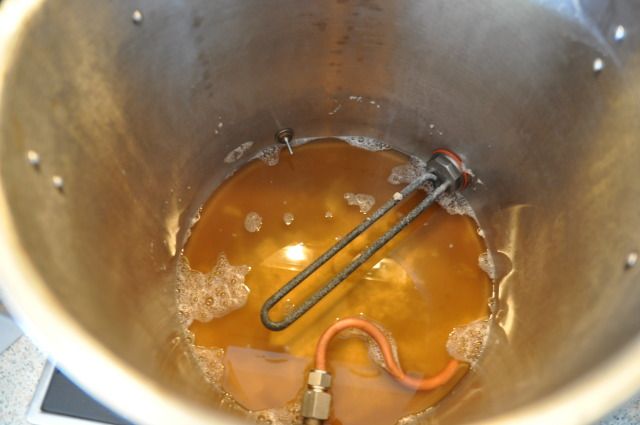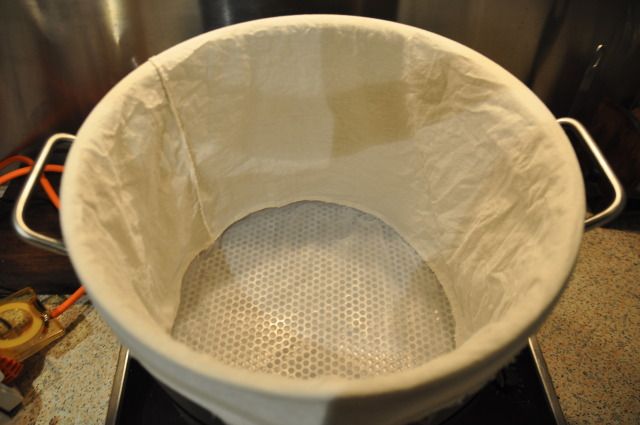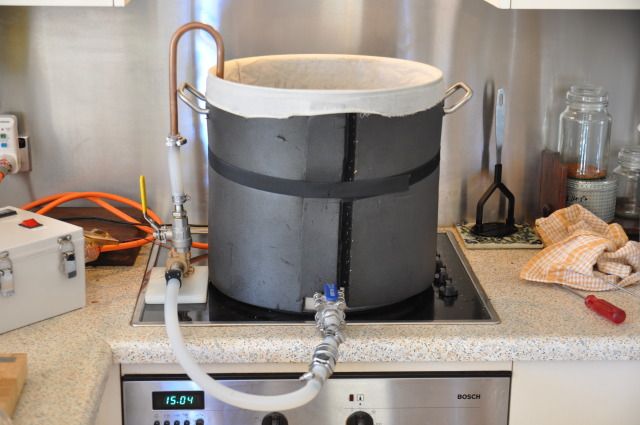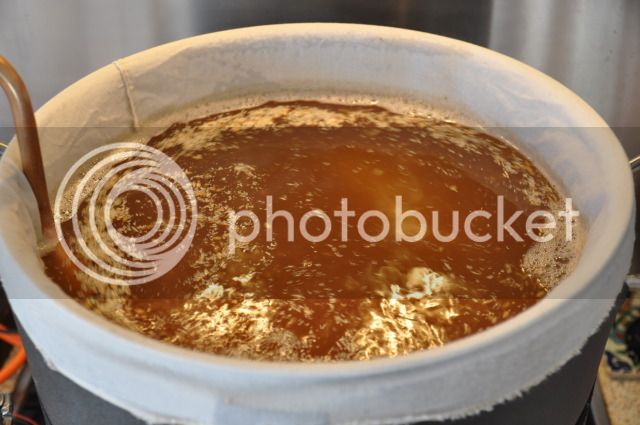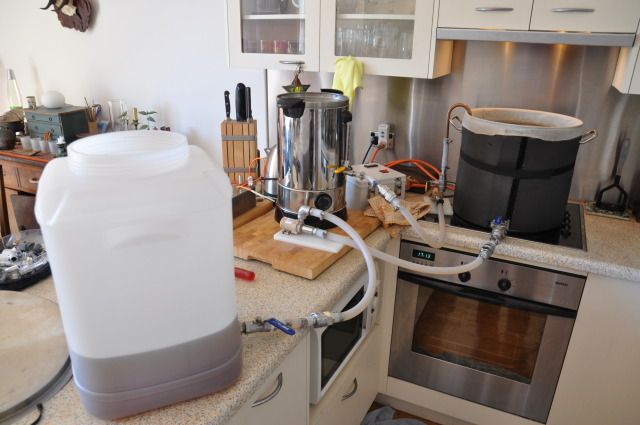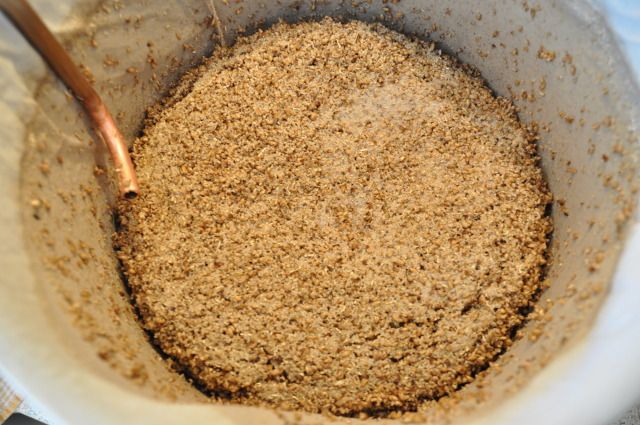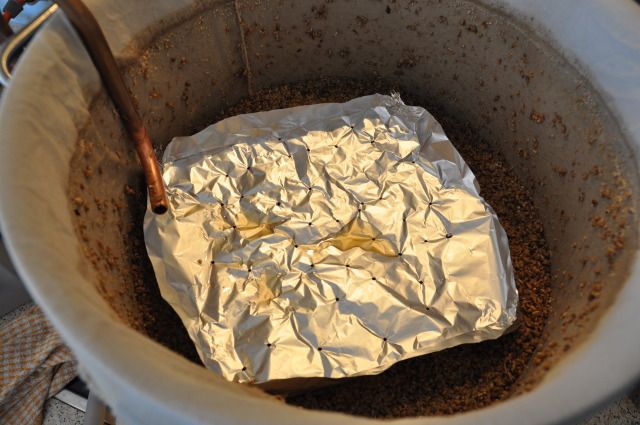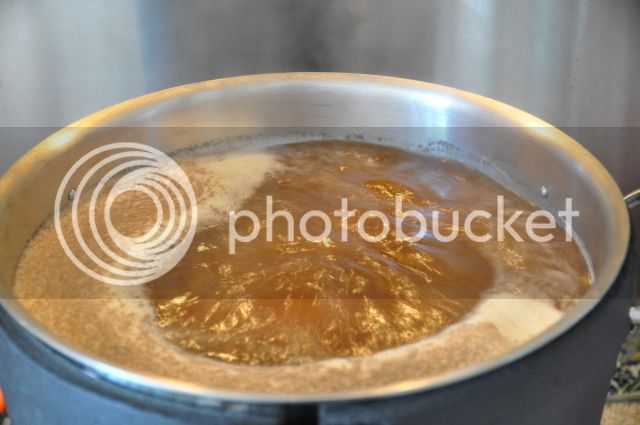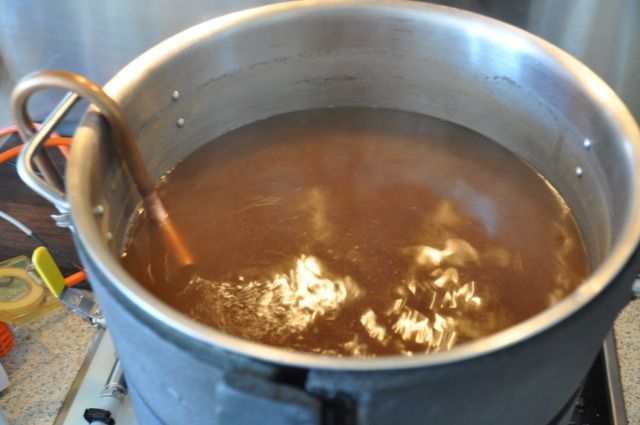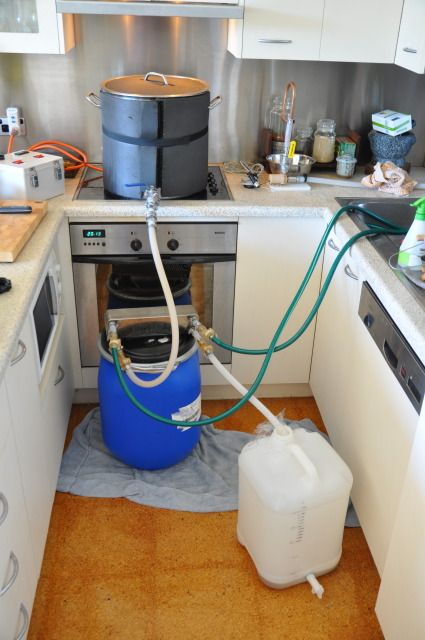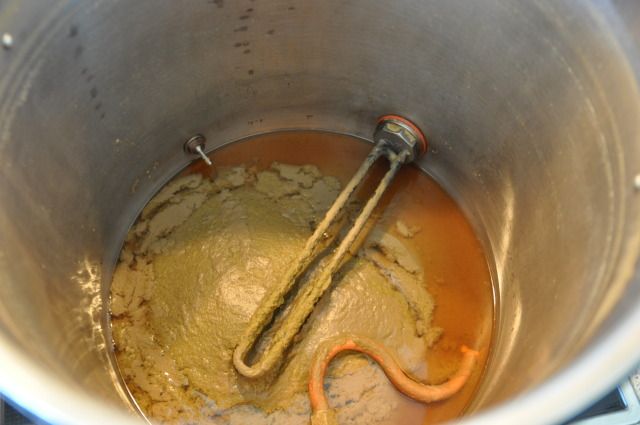black_labb
Well-Known Member
- Joined
- 16/2/10
- Messages
- 1,022
- Reaction score
- 121
I'm starting this thread for my own recently built system but I think with the number popping up we might as well keep a single thread for them here as I suspect we'll be seeing alot more. This could keep most of the information available or linked to from this thread for people looking into designing or building a recirculating single vessel system.
Along with many I've just put together a single vessel brewery. The system uses a hermit/brown pump to recirculate from the bottom of a keggle to the top of the malt pipe. The malt pipe is a bigW 19L pot that I took an angle grinder with a 1.2mm cutoff disc and made slots to hold the grain back. The wort return is a loop of 1/2" copper pipe around the top of the malt pipe.
The heating is a uxcell 2kw stainless element. This is controlled by an Auberins PID ramp/soak controller switching a SSR on and off. This automates the step mashing.
I've brewed with it twice so far. First went well, though I forgot to measure out the water into it and couldn't be bothered reheating the strike water. The lack of volume, inefficient attempt at a fly sparge and a few other things meant the efficiency was in the high 60's. I was also a bit unsure of the grain as it was a bag I had crushed for me a while ago to compare the difference between proper crushing and my corona grain shredder.
Second brew I did full volume and seemed much more promising. The grain was shredded ala corona mill which didn't cause any issues which was great. Haven't measured the exact SG as it is still in the cube but going on the boil volume and the preboil SG it is in the high 70's-low 80's efficiency wise which is perfectly acceptable. Unfortunately the pump died just as things reached mashout temps. I did a quick "sparge" with 2L of 75* water pored through the malt pipe while it drained into the kettle as things came to the boil.
Unfortunately the cube was giving me trouble and didn't end up sealing (threads and seal on the lid are farked, that cube is being retired to lagering and fermenting from now on). I had to head off yesterday as soon as the brew was finished so I returned today with a reliable cube and brought the wort back up to 90* and recubed it as I wasn't ready to pitch yeast. I have no Idea what to expect from the 30g of challenger I used at flameout before the first cubing. I'll probably dry hop with some to make up for any lost aroma. As things go I'll probably nail the best northern brown and never be able to recreate it without recubing.
I still need to do some tweaking on the system before I'm completely happy (and have a look at the pump) before I'm happy to call it completed but I'm happy with how it works and it just needs some adjustment.
Things I want to change
- Add an overflow protection: A simple tube sitting in the malt pipe that connects the bottom of the malt pipe to a point below the rim of the malt pipe. This would mean that when the wort reaches this point it would flow directly to the bottom of the malt pipe instead of overflowing. This would mean that the mashing wouldn't need to be watched and just set the flow to more than you need so that the level above the grain is consistently kept at the level determined by the return pipe.
- Put pump power supply into the control box that can be connected by a 1/4" jack, as opposed to alligator clipping a laptop power supply to the pump wires. Once I've got that sorted I'll add an on switch for the pid, pump as well as an on/off/pid control switch for the element and then clean up the control box.
- Attach pump to a more permanent position, probably with the motor pointing up to avoid it from stoping like it did (assuming it starts to work again once taken apart and cleaned).
- Replace the wort return ring of copper flex pipe with a return that drops vertically from the centre onto a dispersion plate (or whatever the correct name is). This seems like a slightly better system to me but it requires me to drill a 1/2" hole into the glass, or build a new lid, so I'm not in too much of a hurry.
- I'm thinking about making the temp controller modular where I can build it into a box with plug inputs for a number of element outputs so that I can use the controller on a larger system. Only issue is that the controller would have to plug into a different powerpoint and circuit for each 10A of power. This would put the controller in the middle of a network of many wires just to do a double batch. Might just be better to build a second one of these and run them simultaneously as a 19L pot for a malt pipe is cheap, but getting something for a bigger system gets pricey, nevermind the expense of a bigger kettle.
- Possibly weld a malt pipe extension on for doing bigger beers. I suspect I'm going to struggle getting much more than 6kg of grain into the malt pipe. Though I may end up building a bigger system just because I can and use that one for the bigger beers.
Sorry for the lack of photos. I wasn't very motivated for photos once the pump stopped running and much less so when the cube failed to seal and sucked air on me. I'll grab some more photos of the malt pipe and internals soon. The malt pipe looks like the wort is cloudy, though it is actually clear but has bits of grain floating on the top. Even with a terrible crush level the wort filtering through the grain bed is beautifully clear.
A few thoughts I have on the system
- I was expecting to be using the pump to do some fly sparging, but without being albe to restrict flow out of the malt pipe the water does not spend enough time to really dissolve much sugars while passing through the malt pipe. A near full volume mash in seems better then running 1-2L through the malt pipe to dissolve a bit extra seems about right.
- compared to BIAB you will have much less trub. Adjust the pickup tubes location to reflect this.
- Step mashes are very easy, especially with the pid controller.


Along with many I've just put together a single vessel brewery. The system uses a hermit/brown pump to recirculate from the bottom of a keggle to the top of the malt pipe. The malt pipe is a bigW 19L pot that I took an angle grinder with a 1.2mm cutoff disc and made slots to hold the grain back. The wort return is a loop of 1/2" copper pipe around the top of the malt pipe.
The heating is a uxcell 2kw stainless element. This is controlled by an Auberins PID ramp/soak controller switching a SSR on and off. This automates the step mashing.
I've brewed with it twice so far. First went well, though I forgot to measure out the water into it and couldn't be bothered reheating the strike water. The lack of volume, inefficient attempt at a fly sparge and a few other things meant the efficiency was in the high 60's. I was also a bit unsure of the grain as it was a bag I had crushed for me a while ago to compare the difference between proper crushing and my corona grain shredder.
Second brew I did full volume and seemed much more promising. The grain was shredded ala corona mill which didn't cause any issues which was great. Haven't measured the exact SG as it is still in the cube but going on the boil volume and the preboil SG it is in the high 70's-low 80's efficiency wise which is perfectly acceptable. Unfortunately the pump died just as things reached mashout temps. I did a quick "sparge" with 2L of 75* water pored through the malt pipe while it drained into the kettle as things came to the boil.
Unfortunately the cube was giving me trouble and didn't end up sealing (threads and seal on the lid are farked, that cube is being retired to lagering and fermenting from now on). I had to head off yesterday as soon as the brew was finished so I returned today with a reliable cube and brought the wort back up to 90* and recubed it as I wasn't ready to pitch yeast. I have no Idea what to expect from the 30g of challenger I used at flameout before the first cubing. I'll probably dry hop with some to make up for any lost aroma. As things go I'll probably nail the best northern brown and never be able to recreate it without recubing.
I still need to do some tweaking on the system before I'm completely happy (and have a look at the pump) before I'm happy to call it completed but I'm happy with how it works and it just needs some adjustment.
Things I want to change
- Add an overflow protection: A simple tube sitting in the malt pipe that connects the bottom of the malt pipe to a point below the rim of the malt pipe. This would mean that when the wort reaches this point it would flow directly to the bottom of the malt pipe instead of overflowing. This would mean that the mashing wouldn't need to be watched and just set the flow to more than you need so that the level above the grain is consistently kept at the level determined by the return pipe.
- Put pump power supply into the control box that can be connected by a 1/4" jack, as opposed to alligator clipping a laptop power supply to the pump wires. Once I've got that sorted I'll add an on switch for the pid, pump as well as an on/off/pid control switch for the element and then clean up the control box.
- Attach pump to a more permanent position, probably with the motor pointing up to avoid it from stoping like it did (assuming it starts to work again once taken apart and cleaned).
- Replace the wort return ring of copper flex pipe with a return that drops vertically from the centre onto a dispersion plate (or whatever the correct name is). This seems like a slightly better system to me but it requires me to drill a 1/2" hole into the glass, or build a new lid, so I'm not in too much of a hurry.
- I'm thinking about making the temp controller modular where I can build it into a box with plug inputs for a number of element outputs so that I can use the controller on a larger system. Only issue is that the controller would have to plug into a different powerpoint and circuit for each 10A of power. This would put the controller in the middle of a network of many wires just to do a double batch. Might just be better to build a second one of these and run them simultaneously as a 19L pot for a malt pipe is cheap, but getting something for a bigger system gets pricey, nevermind the expense of a bigger kettle.
- Possibly weld a malt pipe extension on for doing bigger beers. I suspect I'm going to struggle getting much more than 6kg of grain into the malt pipe. Though I may end up building a bigger system just because I can and use that one for the bigger beers.
Sorry for the lack of photos. I wasn't very motivated for photos once the pump stopped running and much less so when the cube failed to seal and sucked air on me. I'll grab some more photos of the malt pipe and internals soon. The malt pipe looks like the wort is cloudy, though it is actually clear but has bits of grain floating on the top. Even with a terrible crush level the wort filtering through the grain bed is beautifully clear.
A few thoughts I have on the system
- I was expecting to be using the pump to do some fly sparging, but without being albe to restrict flow out of the malt pipe the water does not spend enough time to really dissolve much sugars while passing through the malt pipe. A near full volume mash in seems better then running 1-2L through the malt pipe to dissolve a bit extra seems about right.
- compared to BIAB you will have much less trub. Adjust the pickup tubes location to reflect this.
- Step mashes are very easy, especially with the pid controller.







